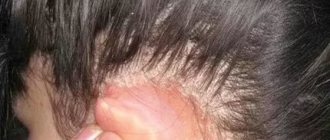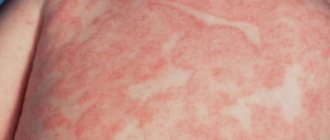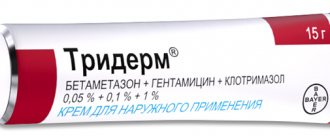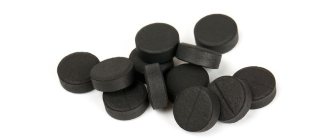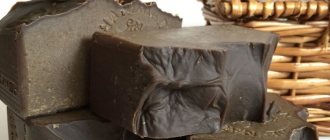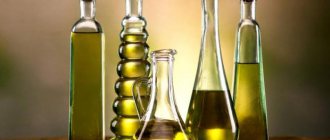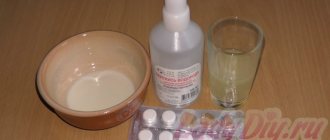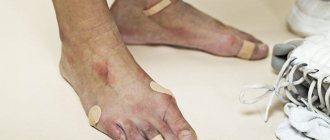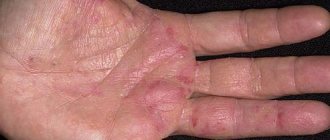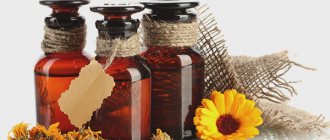Classification of local funds
Often, topical medications are used to treat urticaria: ointments, gels or creams. All drugs differ in their action and composition, but in general they are divided into two types - non-hormonal and hormonal.
The main task of the medicine is to eliminate redness, itching and rash caused by urticaria, as well as to alleviate the general condition of the patient. When visiting a doctor, his choice of the most appropriate remedy will depend on a number of factors:
- the reason that caused the hives;
- the possibility of eliminating the “culprit” of the disease;
- general condition of the patient;
- prevalence of skin manifestations;
- itching intensity;
- appearance of the rash: dry spots, flaky or wet wounds;
- the condition of the skin, especially chronic skin diseases, which directly determines the choice of the right product;
- the patient’s age, the presence of a reaction to the components of the ointment, pregnancy and lactation period.
Despite the fact that you can easily buy ointment for urticaria at the pharmacy, you should not self-medicate. Not all drugs are approved for use by children, nursing mothers, or pregnant women. It is also important to consider the active substance, especially for hormonal ointments. Before treatment, you should definitely consult a doctor!
Not everyone understands the difference between creams, ointments and gels. They differ not only in their structure.
In creams, medicinal components are dissolved by water and oils, due to which they are absorbed faster, but also evaporate faster. Creams do not penetrate deeply into the skin, which is why their effectiveness is not always high. However, the products can be used for urticaria in areas with weeping rashes.
Ointment preparations contain the largest amount of fat, which is why they remain on the skin for a long time after use. The main advantage compared to other types of drugs is the greatest depth of penetration of the active substances into the skin. In addition to the risk of staining clothes, another disadvantage is the prohibition of use on wet skin rashes.
The gels do not contain oils or fats and are water-based with the addition of gelatin, glycerin and other substances that facilitate penetration into the skin. Among the advantages, it should be noted the absence of an oily film on the skin, a good moisturizing, protective and nourishing effect. Suitable for people with very dry skin.
The main difference between hormonal and non-hormonal drugs is the effectiveness of the former due to its components. However, this can also be considered a disadvantage, which is why many people prefer to choose more natural remedies that do not have contraindications and side effects.
When choosing a suitable drug, you should pay attention, first of all, to the severity of the rash in order to quickly get rid of skin itching and other manifestations.
Tablets for urticaria
Antihistamines H1-blockers are divided into three generations. The effectiveness of these substances increases from generation to generation, and the number of side effects decreases. First generation drugs are rarely used in patients with urticaria, but the second and third generation of these drugs are used much more often. The most popular medications among doctors and their patients with allergic diseases are the following:
- Loratadine (Claritin).
- Cetrin (Zodak).
- L-CET (Glenset).
- Erius.
- Ebastine.
The doctor should select a medicine for urticaria, taking into account the age, condition of the patient and the presence of concomitant diseases. It is necessary to take anti-allergy pills for chronic urticaria regularly. This will significantly ease the course of the disease and generally improve the quality of life, since severe itching and cosmetic discomfort create serious problems for patients with urticaria.
Non-hormonal ointments
In ointments without hormones, the active ingredient most often is zinc molecules, which help relieve inflammation, irritation and itching in urticaria; the substance also has a bactericidal effect. Such drugs have a mild effect and are characterized by less pronounced results.
Thanks to its more gentle composition, in most cases it is possible to safely use non-hormonal ointment for urticaria in children, as well as in the presence of skin manifestations in pregnant or breastfeeding women.
Despite the natural composition and the presence of herbal components, even medicine for urticaria without hormones is not recommended for use without prior consultation with a specialist. It should be remembered that self-medication can lead to negative consequences and prolong the recovery period.
Zinc ointment
For urticaria, zinc ointment has anti-inflammatory and antibacterial effects. The remedy is the most common for many skin diseases. The active ingredient is zinc oxide, which also has a drying effect.
The ointment has almost no contraindications or side effects and is widely used in the presence of various manifestations on the skin, both in young children and in pregnant and lactating mothers. It is only worth noting that it cannot be used in case of purulent inflammation.
Store zinc ointment in a dark and cool place. Analogues are also: Desitin, Skin-cap and Tsinocap. The last two drugs contain zinc pyrithione, which increases the antifungal effect.
Fenistil-gel
The active component of the gel is dimethindene, it helps reduce inflammation and itching, and also has an analgesic effect. In addition, Fenistal has other positive effects:
- cooling;
- softening;
- anesthetic.
The gel begins to act within a few minutes after application to the skin. It must be applied 2-4 times a day to the affected areas; it is also suitable for children and pregnant women from the second trimester.
In most cases, Fenistal is well tolerated by patients, but it contains irritating components. The drug is contraindicated for people who are allergic to insect bites or individual intolerance.
It is important to note that Fenistal-gel is used only in case of small lesions.
Psilo-balm
The antihistamine Psilo-balm for urticaria for children and adults promotes rapid penetration into blood vessels and blocking of H1-histamine receptors.
The product copes well with rashes and also helps eliminate itching, irritation and swelling. It is necessary to apply 2-4 times a day. As with previous ointments and gels, it is not used in case of damage to large areas of the skin.
Children, pregnant and lactating women should use the gel with extreme caution; it is not always safe for them. In case of overdose, the following are observed: intoxication of the body, dizziness, dry mouth, low blood pressure and drowsiness.
It is also important to note that the drug provokes photosensitivity, and therefore it is not recommended to go outside in open clothes and, especially, to sunbathe.
Nezulin
A plant-based cream consisting mainly of natural ingredients: chamomile, celandine, plantain, essential oils and others. The composition also includes D-panthenol, which has a calming effect.
The product helps eliminate itching, inflammation, redness and irritation. There are practically no side effects or contraindications. Suitable for any group of patients, with the exception of people with poor tolerance to one of the components of the drug.
The main drawback is that due to its natural composition, the cream is no different in its effectiveness compared to other ointments for urticaria.
La-cree
Another cream with a natural composition based on:
- chamomile, known as an anti-inflammatory herb;
- licorice, which helps improve epidermal regeneration;
- violet, which is an assistant in eliminating itching, redness and has a calming effect;
- string, which has an anti-inflammatory and antipruritic effect;
- walnut, known as an anti-inflammatory and anti-microbial agent.
In addition to the above, the composition also contains panthenol and avocado oil. La-kri is a universal remedy that is also used to treat urticaria. Due to its mild and safe action, it can be used by any patient. However, this is also a drawback - the cream will not cope with severe cases and will not always be effective.
Gistan
Antiallergic cream used in the treatment of urticaria. The composition includes substances that help cope with inflammation and irritation, as well as have anti-allergenic, protective and restorative effects.
The composition of the drug includes natural extracts: lavender, sophora, string and birch buds. Lavender has an antiseptic effect, sophora helps strengthen and restore the skin, string has a bactericidal property, and an extract from birch buds will relieve itching.
Gistan is contraindicated only for persons who are intolerant to any of the components in the composition. An overdose of cream is not observed. The drug should not be confused with Gistan-N; the latter contains the glucocorticosteroid hormone.
Hormonal drugs
The composition of hormonal ointments for urticaria on the skin includes laboratory-created analogues of hormones that are produced by the adrenal glands in the human body. The components of hormonal drugs have powerful antiallergic and antipruritic effects.
According to the strength of the effect, the products are divided into four types:
- Weak. The list of weak medications for urticaria includes: Hydrocortisone, Flucinar, Prednisolone.
- Medium impact force. Moderate strength of ointments: Lorinden, Dermatop, Ftorokort, Afloderm.
- Strong. Among the strong remedies it is worth noting: Advantan, Lokoid, Celestoderm, Elokom.
- Very strong. The most effective are: Dermovate and Haliciderm.
In the weak and medium groups, medications are more similar in structure to natural adrenal hormones; they have a weaker effect. The last two groups are more effective, but contain modified hormones and increase the risk of various side effects: swelling, skin atrophy, increased blood pressure and glucose levels.
There is a particularly high risk of a negative reaction on the patient’s face, so it is safer to use such products on the torso or arms. In this regard, most often the doctor prescribes drugs from the first two groups. If stronger ointments are required, then they are prescribed in short courses.
Due to the risk of side effects and limitations, hormonal creams in the treatment of urticaria are selected carefully and individually. It is highly not recommended to self-medicate, so you should first consult a doctor.
The most common ointments for urticaria containing hormones:
- Hydrocortisone. The synthetic glucocorticosteroid contained in the ointment is an antihistamine that helps relieve inflammation and swelling. The product is noted for its fast and effective action. Despite the significant advantage, the medicine is not used for children under two years of age, as well as in the presence of a fungus, an inflammatory process on the mucous membrane, open wounds, rosacea, bleeding rashes. Hydrocortisone should be used with caution in situations where a patient with urticaria has impaired renal and liver function or is diagnosed with diabetes mellitus; this list also includes pregnancy and lactation.
- Prednisolone. Prednisolone ointment contains prednisolone, which has a powerful anti-allergic and anti-inflammatory effect. When used topically, the drug will quickly eliminate itching, redness and other symptoms of urticaria. Side effects include: erythema, burning, irritation and increased hair growth.
- Advantan. Available in the form of cream or ointment, depending on skin type. The latest generation steroid drug affects the body’s immune processes and thereby blocks the allergic reaction. The product is considered quite effective and is characterized by minimal negative reactions: acne, burning, itching. These manifestations are possible mainly only if the dosage of Advantan is exceeded. Do not use in children under 4 months of age or in patients with syphilis, tuberculosis or various viral diseases.
- Ecolom. It has a light texture and is also sold in two forms. Ekolom has a wide spectrum of action and high efficiency. It is enough to apply the medicine once a day. You should be careful, an overdose can cause dysfunction of the adrenal glands.
- Soderm. The main active component is betamethasone, which is a glucocorticosteroid of synthetic origin. The ointment copes well with the manifestations of urticaria, but is used only on small areas of the patient’s skin. In situations with extensive lesions it is completely unsuitable for use. Soderm is approved only for adults; it is not prescribed for children, as well as for various viruses.
- Lorinden S. The active ingredient is clioquinol, which copes well with the symptoms of urticaria. Among the advantages of the ointment: antifungal, antibacterial, anti-inflammatory effects. In addition, Lorinden will help quickly relieve swelling and eliminate itching. The main disadvantage is that the skin may atrophy with prolonged use of the product. Not used in the treatment of children.
Common treatment method
There are common methods of treating urticaria, which are based on the same drugs:
- Antihistamines. For example, Suprastin. It is widely prescribed to both adults and children to relieve the symptoms of the disease. Helps with itching, can relieve pain, and so on.
- Homeopathic medicines. They are gaining more and more popularity.
- Ointments with hormones. Prescribed for profuse rashes, in severe cases. They help quickly, but they also have a negative impact.
- Dexamethasone and Prednisolone. Used in hospital treatment. Only under the supervision of doctors.
Ointments and creams can quickly remove inflammation from the skin, relieve itching, burning, and pain. However, many of them contain hormones, so they should be used only after consulting a doctor.
Bottom line
As soon as a person discovers the symptoms of urticaria, one of the first thoughts is: how to smear it? There is a huge selection of ointments on the market, but before choosing the right one, you should consult a doctor, he will prescribe the safest and most effective remedy.
Ointments are divided into non-hormonal and hormonal and have several differences. The main advantage of the former is their safe composition and herbal ingredients, but for this reason their effectiveness is not at the highest level.
A significant advantage of the latter is its effectiveness, but there are also considerable disadvantages: side effects, in some cases serious, the impossibility of using a significant part of the drugs in the treatment of children, pregnant or nursing mothers.
